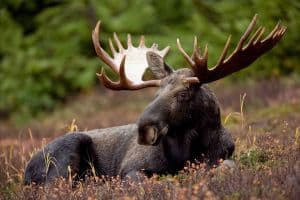
The moose of Minnesota are disappearing, despite a halt to hunting and intensive research into the causes. Ever since the population was cut in half in the span of the last decade, the state of Minnesota has been trying to figure out why, and what can be done.
Now, environmentalists are asking the federal government to designate the species as endangered. The Center for Biological Diversity and Honor the Earth (an indigenous environmental justice organization founded by Winona LaDuke) filed a request this week to add the species in the upper Midwest to the Endangered Species List.
“Native people and the moozoog — our Ojibwe word — have coexisted for thousands of years in Anishinaabe akiing,” LaDuke said in a statement. “The destruction of habitat by mining and logging industries, as well as overharvesting, is destroying this relative. Any listing should include a full coordination with tribal governments and First Nations, in keeping with the treaty agreements. Our culture is tied to the moozoog and we will work to protect them.”
In the petition to the U.S. Fish & Wildlife Service (USFWS), the organizations acknowledge that the reasons moose are dwindling are complex and still not very understood, but the primary is a “combination of climate change, and disease, and parasites, and habitat curtailment.”
Whatever the exact reasons, Center for Biological Diversity lawyer Collette Adkins wrote in a MinnPost commentary that scientists also think the moose could be gone from Minnesota in five years – and points to global warming as the biggest factor.
It’s believed that climate change is causing moose to overheat in summer, while also causing their preferred boreal forest habitat to disappear in northern Minnesota. Higher temperatures also make them more susceptible to ticks, parasites, and disease.
The groups say that if moose are listed as endangered by the federal government, it could mean more funding for research, habitat protection, and attention to the ecological problems caused by burning fossil fuels.
The Minnesota Department of Natural Resources does not think moose need to be listed as endangered to be protected. “We’re doing everything we can to find out what’s causing this decline. Federal listing can’t stop any of the moose mortality we’re seeing now. … There is no hunting season and we don’t have plans for one,” DNR wildlife manager Lou Cornicelli told the Duluth News Tribune.
The USFWS has several months to respond to the petition and consider recommending the species for addition to the Endangered Species list.

